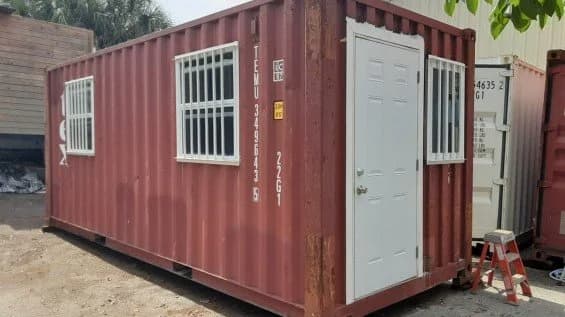Shipping containers are renowned for being mobile and adaptable. It can be simple to overlook the fact that they are also very secure structures.
Because they can withstand the elements, shipping containers are becoming more and more common as dormitories for workers, storage facilities, and offices. Extreme winds, precipitation, and even burglary are all things that these units can effectively protect against.
It’s crucial to remember that shipping containers are regarded as wind- and watertight when used as cargo boxes, which means they keep out both elements. Containers can travel on ships with the stored contents safe thanks to protection against these elements.
The units are no longer regarded as wind and watertight after manufacturers modify containers because the original design has been altered.
The responsibility of making repurposed containers weather resistant or capable of withstanding the effects of weather falls on the manufacturers. Even though modified containers are not thought to be wind and watertight for sea travel, they are still remarkably dependable structures.
What Does Watertight Mean?
Currently, goods are being shipped and transported all over the world, and while they are in transit, they need to be protected from the elements like rain and weather. The most widely used method is, by far, shipping containers.
Due to their dependability and practicality, shipping containers have transformed global trade since they were first introduced in the 1950s.
Related Article: Are Shipping Containers Fireproof?
Simply put, due to the harsh weather that shipping containers must withstand, they are frequently required to be watertight. Watertight means that it is hard for water to penetrate. When a shipping container is on a ship’s deck or riding on the back of a truck or rail car, it may experience ferocious waves or a pounding downpour.
Shipping containers frequently have to withstand the worst that nature can muster, regardless of the situation.
It is clear what is meant when something is described as “watertight,” i.e., that no water can enter the container in question.
While it’s still crucial to purchase from a reputable supplier, if you see the term “watertight” used to describe a shipping container, you can reasonably assume that it claims to give your goods complete protection.
Are Shipping Containers Really Watertight?
Most of the time, shipping containers are watertight. The doors of the majority of modern shipping containers are manufactured with tough rubber seals that keep out any water or moisture. The majority of containers only have one side that can be opened, so by strengthening the area around their doors; they can effectively block out water.
You won’t find watertight containers in every market, though. The “as-is” resale of containers with broken seals frequently occurs at a discount and frequently provides less protection.
Ultimately, it’s crucial for any buyer of a shipping container to work with a reputable supplier and thoroughly investigate the container’s condition before making a purchase.
Water resistance of a container can also be significantly influenced by condensation, the process by which moisture cools and turns into liquid water.
Some older shipping containers may allow moisture to enter if left on the ground and exposed to temperature variations.
Shipping companies may need to take extra precautions to safeguard their cargo if it is particularly susceptible to water damage because even watertight containers aren’t always wholly immune to this occurrence.
However, the container will likely be more resistant to condensation if it is more recent.
There are other options available for companies that need to increase their shipping container weather and water resistance, especially when dealing with circumstances where condensation is likely.
Using plastic pallets rather than wooden ones can be one of the easiest and best options because they are more resistant to absorbing moisture from condensation than wooden pallets are.
Other well-liked options for moisture control include silica and calcium chloride desiccants. Individual items can also be packaged in moisture-controlling materials like vermiculite to help keep them safe.
All shipping container buildings must first protect from the elements. Weather-resistant containers have proven themselves as cargo boxes traveling across oceans by withstanding not only changes in temperature but also storms and strong winds. Despite manufacturer modifications, shipping containers continue to be weather- and wind-resistant.
Finding a new or used shipping container that will shield your cargo from water is simple, thanks to CMG Containers. Our containers have secure locking mechanisms, secure flooring, and excellent water and weather resistance. They are also wind and watertight. For shipping containers, packaging supplies, and much more, turn to CMG Containers!
FAQ
- Can a shipping container withstand a flood?
In most cases, shipping containers can withstand powerful winds, storms, and floods. Thanks to their quality material and production process, shipping containers are highly resistant to water and wind. However, this does not mean that a shipping container is completely impervious to flood.
- Are shipping containers rust-proof?
Shipping containers are corrosion-resistant, meaning the steel used in shipping containers slows the process of rusting. However, they are not rust-proof entirely and must be protected from excessive moisture exposition and appropriately maintained.


